The Adaptability of Cities to Climate Change: Evidence from Cities’ Redesign towards Mitigating the UHI Effect
Abstract
1. Introduction
2. Materials and Methods
- ▪
- Investigation of the current UHI performance of the existing fabric and the nearby empty field;
- ▪
- Investigation of the same area, with a new development proposed at the empty field at the west. The new development maintains similar scale, building densities, and coverage as the surrounding fabric. Several mitigation strategies also apply which include the following:
- Coverage management, building volumes, and heights in relation to the open spaces and their orientation designed to minimize solar heat trapping;
- A dry stream as an existing natural feature is preserved and turned into a water feature; soil sealing is minimized, while greenery and trees are maximized;
- High albedo and low heat capacity materials are strategically used for pavements and external surfaces.
2.1. Investigated Site
- ▪
- The baseline scenario presents the current status of the investigated area, with conventional construction and materials and more impervious surfaces with no vegetation or trees;
- ▪
- The green scenario includes impervious surfaces and vegetation. In this advanced design scenario, more bioclimatic design elements, building types and heights, as well as vegetated types, pervious surfaces, and vegetation were included.
- ▪
- Part A consisted of 10 building blocks, arranged in ‘L’ and ‘U’ shapes, open towards the south in order to allow maximum heat gain inside the buildings. The height of the buildings was 15 m. The land surface consisted of soil and paving materials, in order to identify differences between them. The trees faced west along the street. On the road between the buildings, two arrays of trees were placed at the southern and northern sides of the road, respectively. Under the specific case, the contribution of the trees to the mitigation of the high temperatures, caused by the impervious materials, was evaluated;
- ▪
- Part B consisted of a green corridor, which included an array of trees, as well as a lake. The land surface consisted of soil, which was located in the middle of the plot, dividing the two types of buildings. This part was aimed at evaluating the impact of a green corridor on the plot and on the site area, and specifically at assessing whether using materials of high thermal mass helped to decrease the temperature;
- ▪
- Part C consisted of 11 building blocks arranged around a square. The height of these buildings was assumed to be 12 m. The land surface consisted of soil and pavement materials, in order to identify the differences between them. The absence of trees was also taken into consideration. Based on this configuration, the interactions between the impervious and permeable soil surfaces were evaluated, as well as the temperature increase caused by the absence of trees.
2.2. Computational Tool: ENVI-Met Model
2.3. ENVI-Met Air Temperature Validation
- ▪
- An atmospheric module, which computes air motion, 3-D turbulence, temperature, and relative humidity, taking into consideration obstacles (e.g., buildings, vegetation). The difference of radiation due to vegetation is also included in the analysis;
- ▪
- A surface module, which analyses the emitted longwave and reflected shortwave radiation from diverse surfaces, taking into consideration the incident longwave and shortwave radiation. It reflects the albedo of the exteriors and shade as a function of the solar path and computes water vapor evaporation from the vegetation and transpiration from the soil, in view of the airflow-modifying effect of the vegetation. It is adapted to model flat surfaces;
- ▪
- A vegetation module, which computes foliage temperature and the energy balance of the leaves, considering physiological and meteorological parameters;
- ▪
- A soil module, which computes the thermo- and hydrodynamic processes that take place in the soil. This model considers the combination of the natural and artificial surfaces of the selected neighborhood, and it can also calculate heat exchange between a water body and its environment.
3. Results and Discussion
3.1. Baseline Scenario
3.2. Proposed Urban Development for the Unbuilt Area
3.3. Urban Heat Island Effect for the Unbuilt Area for the Proposed Development
4. Conclusions
Author Contributions
Funding
Institutional Review Board Statement
Informed Consent Statement
Data Availability Statement
Conflicts of Interest
References
- Santamouris, M.; Ding, L.; Osmond, P. Urban heat island mitigation. In Decarbonising the Built Environment: Charting the Transition; Springer: Berlin/Heidelberg, Germany, 2019; pp. 337–355. [Google Scholar]
- Yang, J.; Santamouris, M. Urban Heat Island and Mitigation Technologies in Asian and Australian Cities—Impact and Mitigation. Urban Sci. 2018, 2, 74. [Google Scholar] [CrossRef]
- Founda, D.; Santamouris, M. Synergies between Urban Heat Island and Heat Waves in Athens (Greece), during an extremely hot summer (2012). Sci. Rep. 2017, 7, 10973. [Google Scholar] [CrossRef] [PubMed]
- Panteli, C.; Klumbytė, E.; Apanavičienė, R.; Fokaides, P.A. An overview of the existing schemes and research trends in financing the energy upgrade of buildings in Europe. J. Sustain. Archit. Civ. Eng. 2020, 27, 53–62. [Google Scholar] [CrossRef]
- Kylili, A.; Afxentiou, N.; Georgiou, L.; Panteli, C.; Morsink-Georgalli, P.Z.; Panayidou, A.; Fokaides, P.A. The role of Remote Working in smart cities: Lessons learnt from COVID-19 pandemic. Energy Sources Part A Recovery Util. Environ. Eff. 2020, 1–16. [Google Scholar] [CrossRef]
- Fokaides, P.A.; Christoforou, E.A.; Kalogirou, S.A. Legislation driven scenarios based on recent construction advancements towards the achievement of nearly zero energy dwellings in the southern European country of Cyprus. Energy 2014, 66, 588–597. [Google Scholar] [CrossRef]
- Fantozzi, F.; Gargari, C.; Rovai, M.; Salvadori, G. Energy Upgrading of Residential Building Stock: Use of Life Cycle Cost Analysis to Assess Interventions on Social Housing in Italy. Sustainability 2019, 11, 1452. [Google Scholar] [CrossRef]
- Bouyer, J.; Musy, M.; Huang, Y.; Athamena, K. Urban Heat Island Effect by Urban Design: Forms and Materials. In Cities and Climate Change: Responding to an Urgent; AgendaHoornweg, D., Freire, M., Lee, M., Bhada-Tata, P., Yuen, B., Eds.; The Worldbank: Washington, DC, USA, 2012; Volume 2, pp. 164–181. [Google Scholar]
- Santamouris, M. Urban Warming and Mitigation: Actual status, impacts and challenges. In Urban Climate Mitigation Techniques; Santamouris, M., Kolokotsa, D., Eds.; Earthscan: London, UK, 2016; pp. 1–26. [Google Scholar]
- Li, X.; Zhou, Y.; Yu, S.; Jia, G.; Li, H.; Li, W. Urban heat island impacts on building energy consumption: A review of approaches and findings. Energy 2019, 174, 407–419. [Google Scholar] [CrossRef]
- Moon, S.-Y.; Kim, J.; Chong, W.K.O.; Ariaratnam, S.T. Urban Green Space Layouts and Urban Heat Island: Case Study on Apartment Complexes in South Korea. J. Urban Plan. Dev. 2018, 144, 04018004. [Google Scholar] [CrossRef]
- Zhou, Y.; Zhuang, Z.; Yang, F.; Yu, Y.; Xie, X. Urban morphology on heat island and building energy consumption. Procedia Eng. 2017, 205, 2401–2406. [Google Scholar] [CrossRef]
- Sobsty, J.; Thorsten, E.; Abdolhosseini, M.; Ulm, F.-J.; Pellenq, R. Role of City Texture in Urban Heat Islands at Nighttime. Phys. Rev. Lett. 2018, 120, 108701. [Google Scholar] [CrossRef]
- Gatto, E.; Buccolieri, R.; Aarrevaara, E.; Ippolito, F.; Emmanuel, R.; Perronace, L.; Santiago, J.L. Impact of Urban Vegetation on Outdoor Thermal Comfort: Comparison between a Mediterranean City (Lecce, Italy) and a Northern European City (Lahti, Finland). Forests 2020, 11, 228. [Google Scholar] [CrossRef]
- Emmanuel, R.; Loconsole, A. Green infrastructure as an adaptation approach to tackling urban overheating in the Glasgow Clyde Valley Region, UK. Landsc. Urban Plan. 2015, 138, 71–86. [Google Scholar] [CrossRef]
- Kohler, M.; Tannier, C.; Blond, N.; Aguejdad, R.; Clappier, A. Impacts of several urban-sprawl countermeasures on building (space heating) energy demands and urban heat island intensities. A case study. Urban Clim. 2017, 19, 92–121. [Google Scholar] [CrossRef]
- Roman, K.K.; O’Brien, T.; Alvey, J.; Woo, O. Simulating the effects of cool roof and PCM (phase change materials) based roof to mitigate UHI (urban heat island) in prominent US cities. Energy 2016, 96, 103–117. [Google Scholar] [CrossRef]
- Hirano, Y.; Fujita, T. Evaluation of the impact of the urban heat island on residential and commercial energy consumption in Tokyo. Energy 2012, 37, 371–383. [Google Scholar] [CrossRef]
- Morakinyo, T.E.; Balogun, A.A.; Adegun, O.B. Comparing the effect of trees on thermal conditions of two typical urban buildings. Urban Clim. 2013, 3, 76–93. [Google Scholar] [CrossRef]
- Gemechu, F. Review of urban surface parameterizations for numerical climate models. Urban Clim. 2018, 24, 830–851. [Google Scholar]
- Ramakreshnan, L.; Aghamohammadi, N.; Fong, C.S.; Ghaffarianhoseini, A.; Wong, L.P.; Noor, R.; Hanif, N.R.; Aziz, W.N.A.W.A.; Sulaiman, N.M.; Hassan, N. A qualitative exploration on the awareness and knowledge of stakeholders towards Urban Heat Island phenomenon in Greater Kuala Lumpur: Critical insights for urban policy implications. Habitat Int. 2019, 86, 28–37. [Google Scholar] [CrossRef]
- Crank, P.J.; Sailor, D.J.; Ban-Weiss, G.; Taleghani, M. Evaluating the ENVI-met microscale model for suitability in analysis of targeted urban heat mitigation strategies. Urban Clim. 2018, 26, 188–197. [Google Scholar] [CrossRef]
- ENVI-met. Calculate the Microclimate of a City Down to the Square Metre. 2023. Available online: https://www.envi-met.com/ (accessed on 5 February 2023).
- Salata, F.; Golasi, I.; de Lieto Vollaro, A.; de Lieto Vollaro, R. How high albedo and traditional buildings’ materials and vegetation affect the quality of urban microclimate. A case study. Energy Build. 2015, 99, 32–49. [Google Scholar] [CrossRef]
- Theophilou, M.; Serghides, D. Estimating the characteristics of the Urban Heat Island Effect in Nicosia, Cyprus, using multiyear urban and rural climatic data and analysis. Energy Build. 2015, 108, 137–144. [Google Scholar] [CrossRef]
- Hadjimitsis, D.; Retalis, A.; Michaelides, S.; Tymvios, F.; Paronis, D.; Themistocleous, K.; Agapiou, A. Satellite and Ground Measurements for Studying the Urban Heat Island Effect in Cyprus, In Remote Sensing of Environment: Integrated Approaches; Hadjimitsis, D., Ed.; Intechopen: London, UK, 2013; pp. 1–24. [Google Scholar] [CrossRef]
- Fokaides, P.A.; Kylili, A.; Nicolaou, L.; Ioannou, B. The effect of soil sealing on the urban heat island phenomenon. Indoor Built Environ. 2016, 25, 1136–1147. [Google Scholar] [CrossRef]
- Cui, Y.; Yan, D.; Hong, T.; Ma, J. Temporal and spatial characteristics of the urban heat island in Beijing and the impact on building design and energy performance. Energy 2017, 130, 286–297. [Google Scholar] [CrossRef]
- Guo, X.; Hendel, M. Urban water networks as an alternative source for district heating and emergency heat-wave cooling. Energy 2018, 145, 79–87. [Google Scholar] [CrossRef]
- Kaimakli—Wikipedia Article. Available online: https://en.wikipedia.org/wiki/Kaimakli (accessed on 14 July 2018).
- Miner, M.J.; Taylor, R.A.; Jones, C.; Phelan, P.E. Efficiency, economics, and the urban heat island. Environment and Urbanization. 2017, 29, 183–194. [Google Scholar] [CrossRef]
- Mirzaei, P.A. Recent challenges in modeling of urban heat island. Sustain. Cities Soc. 2015, 19, 200–206. [Google Scholar] [CrossRef]
- Halder, B.; Bandyopadhyay, J.; Banik, P. Monitoring the effect of urban development on urban heat island based on remote sensing and geo-spatial approach in Kolkata and adjacent areas, India. Sustain. Cities Soc. 2021, 74, 103186. [Google Scholar] [CrossRef]
- Li, S.Y.; Han, J.Y. The impact of shadow covering on the rooftop solar photovoltaic system for evaluating self-sufficiency rate in the concept of nearly zero energy building. Sustain. Cities Soc. 2022, 80, 103821. [Google Scholar] [CrossRef]
- National Oceanic and Atmospheric Association. Available online: http://www.noaa.gov/climate-data-and-reports (accessed on 14 July 2018).
- EnviMET: Decoding Urban Nature. Available online: https://www.envi-met.com/ (accessed on 14 July 2018).
- Grifoni, R.C.; Sargolini, M.; D’Onofrio, R. Quality of Life in Urban Landscapes; Springer: Berlin/Heidelberg, Germany, 2018. [Google Scholar]
- Szecs, Á. Wind comfort in a public urban space-case study within Dublin Docklands. Front. Archit. Res. 2013, 2, 50–66. [Google Scholar] [CrossRef]
- Morini, E.; Touchaei, A.G.; Rossi, F.; Cotana, F.; Akbari, H. Evaluation of albedo enhancement to mitigate impacts of urban heat island in Rome (Italy) using WRF meteorological model. Urban Clim. 2018, 24, 551–566. [Google Scholar] [CrossRef]
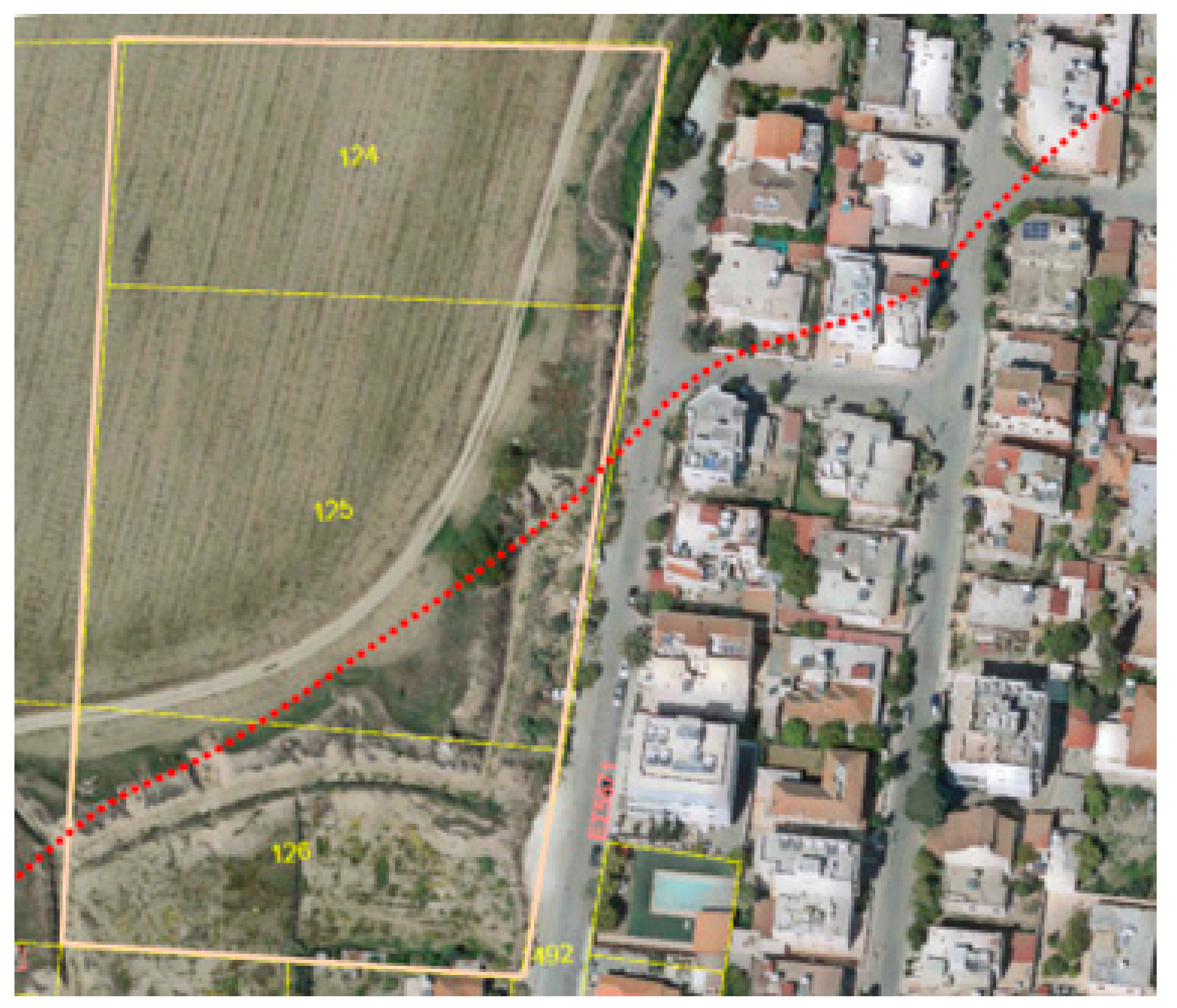
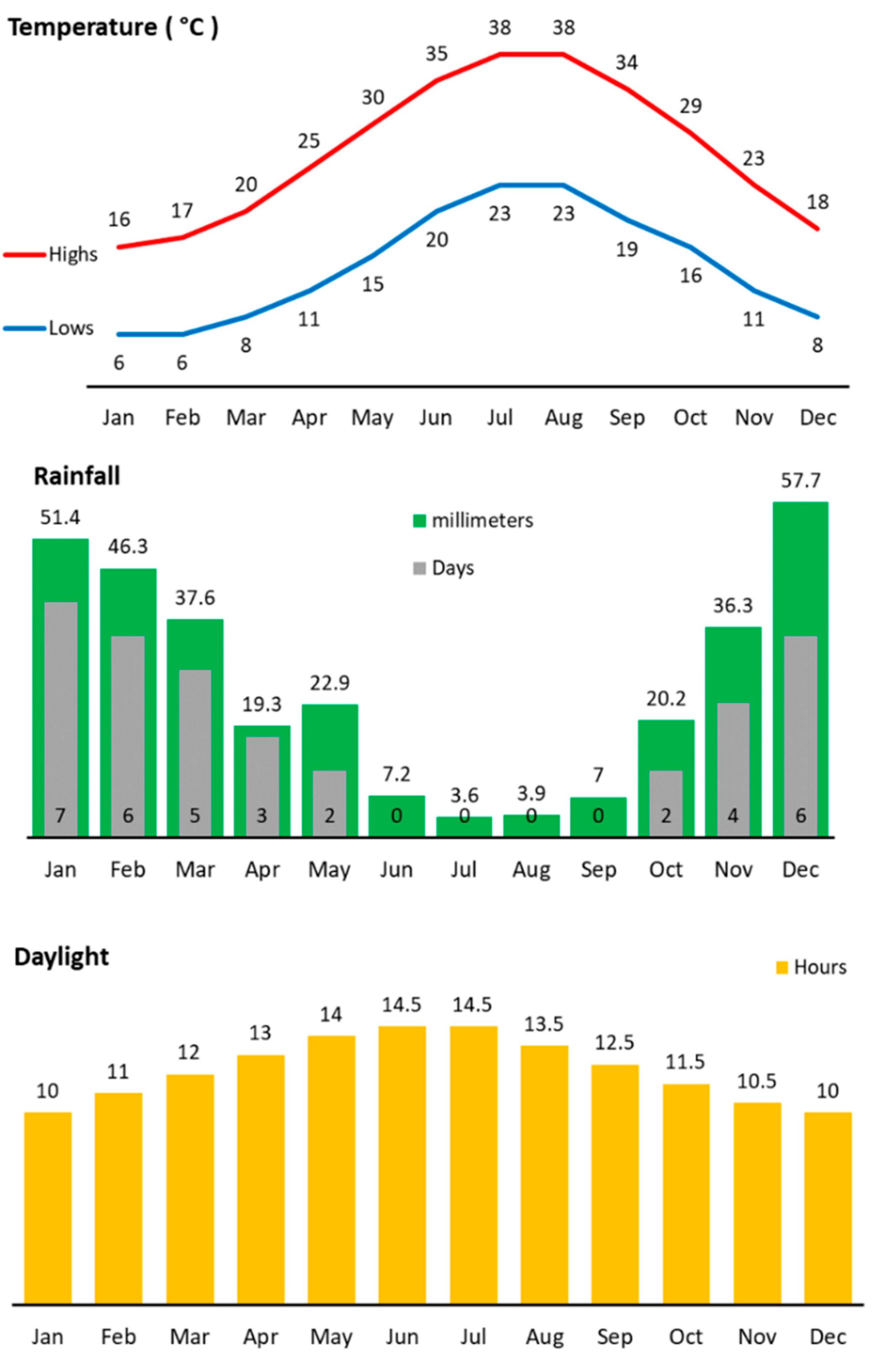

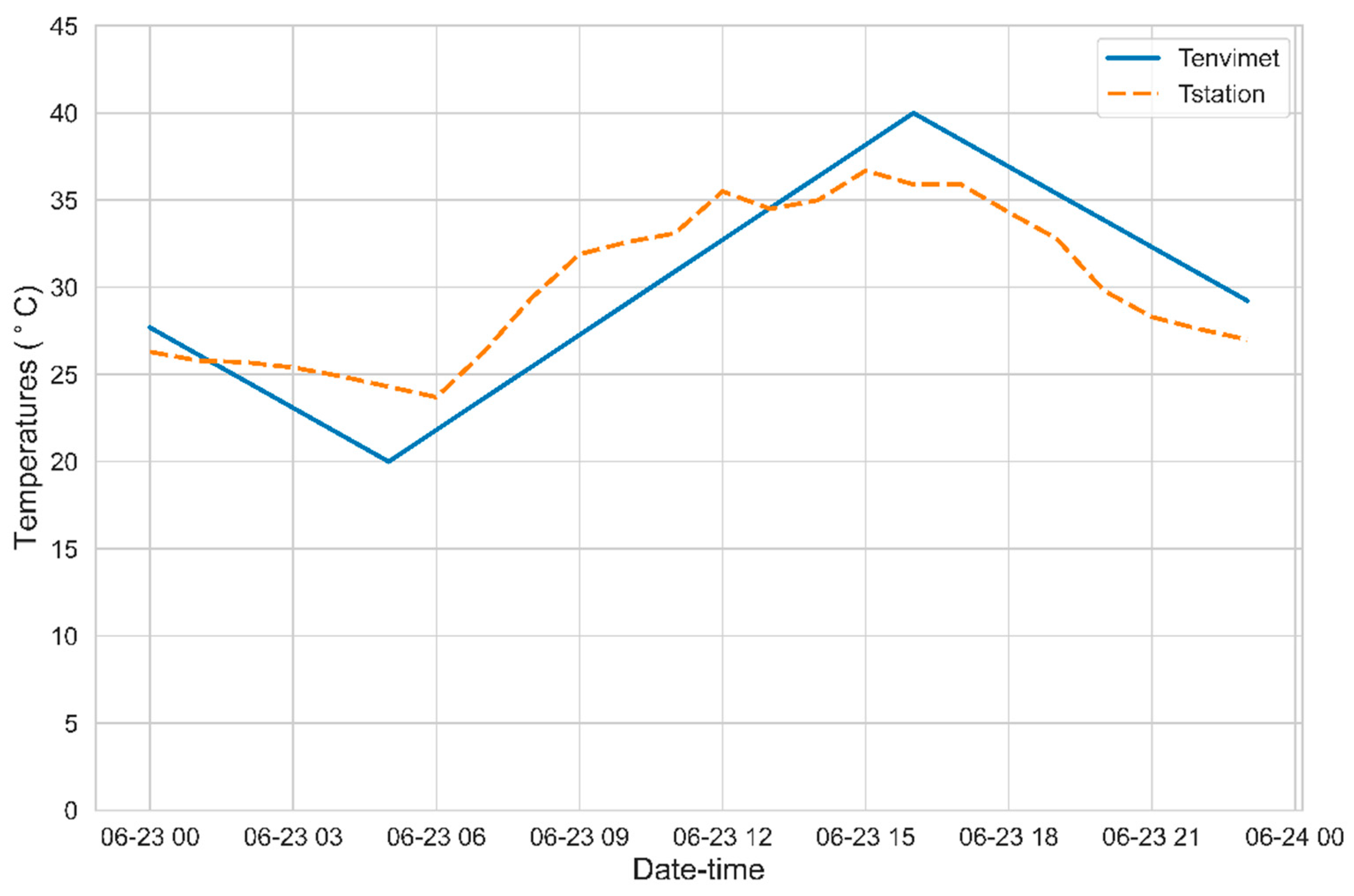
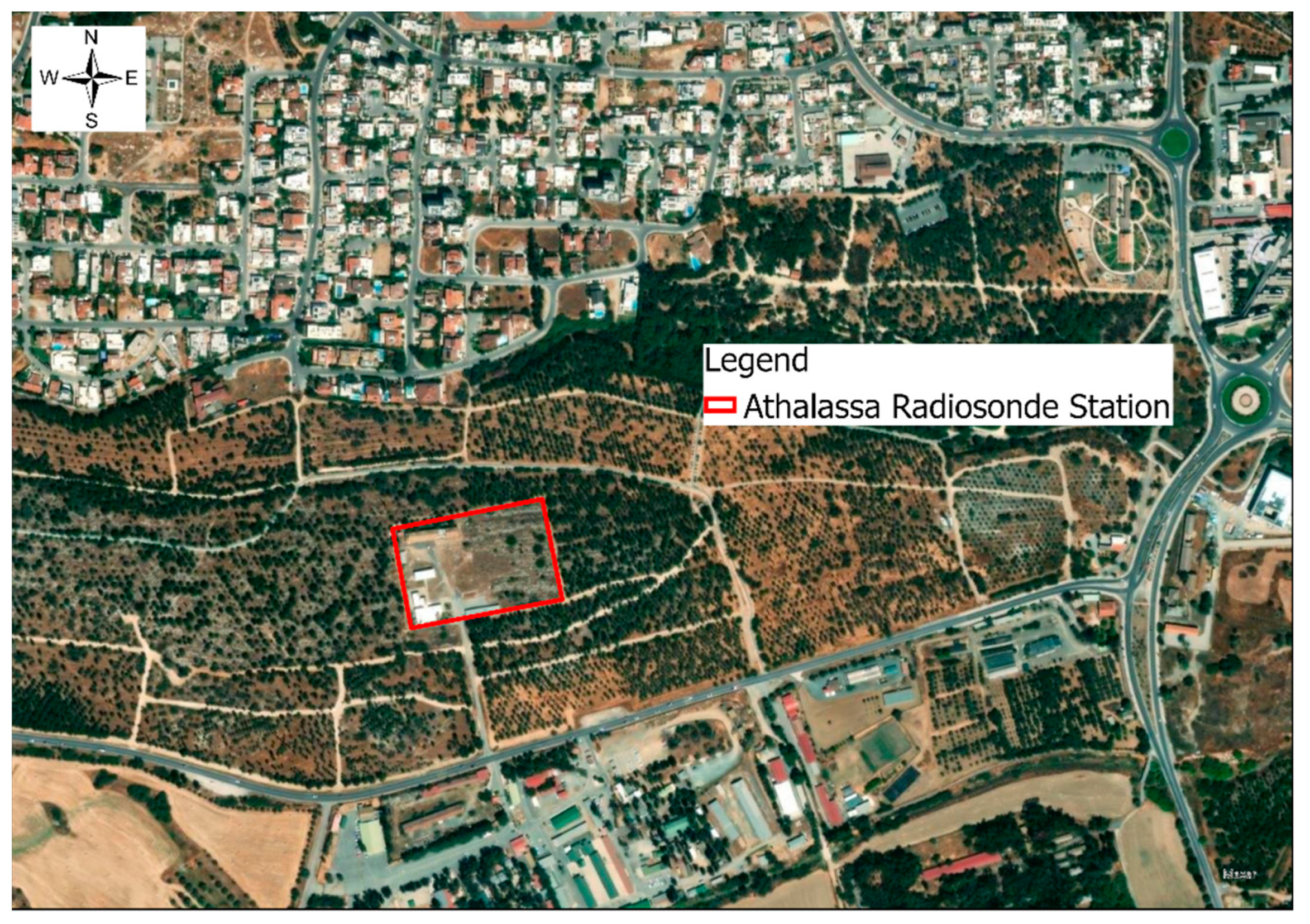
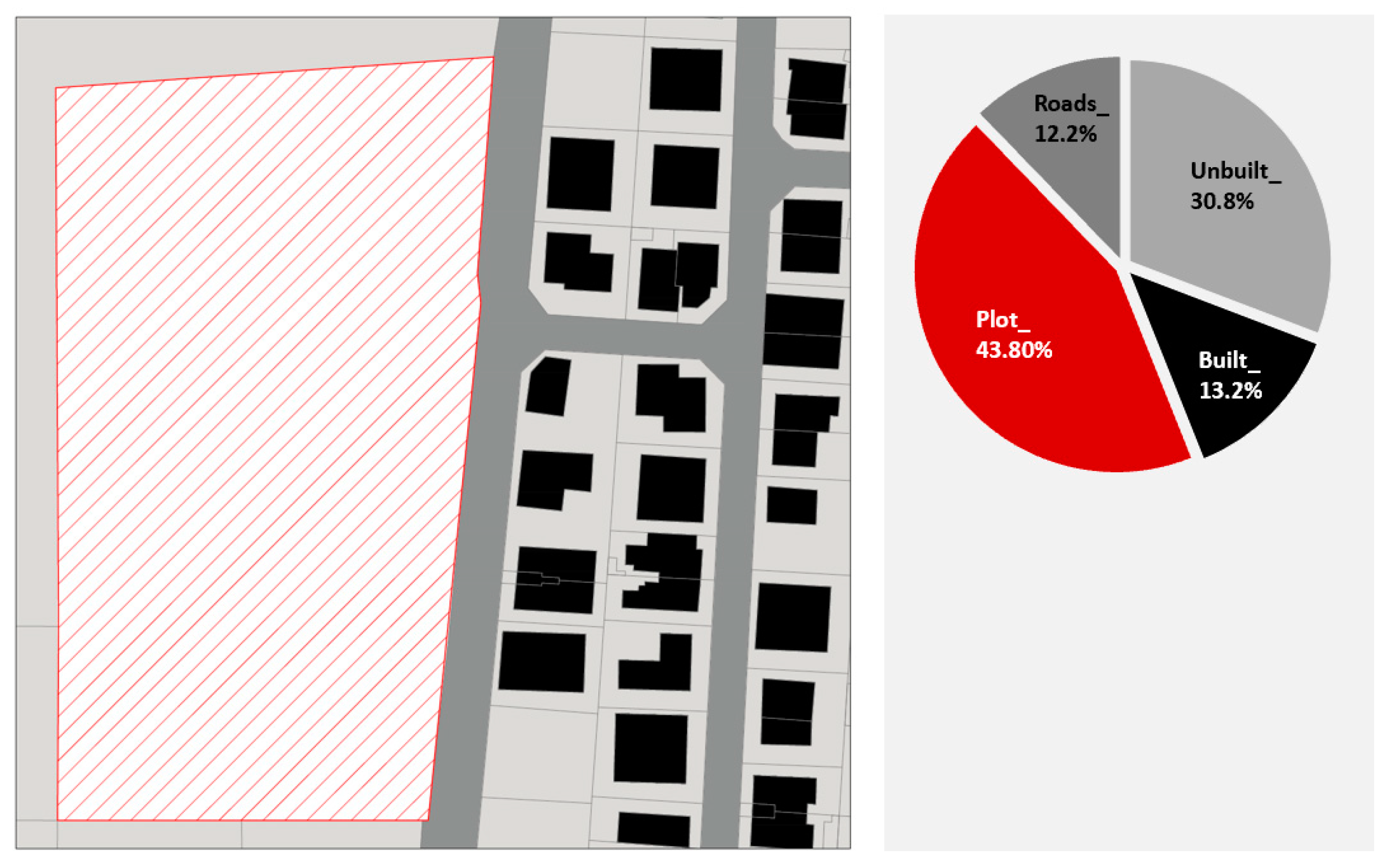

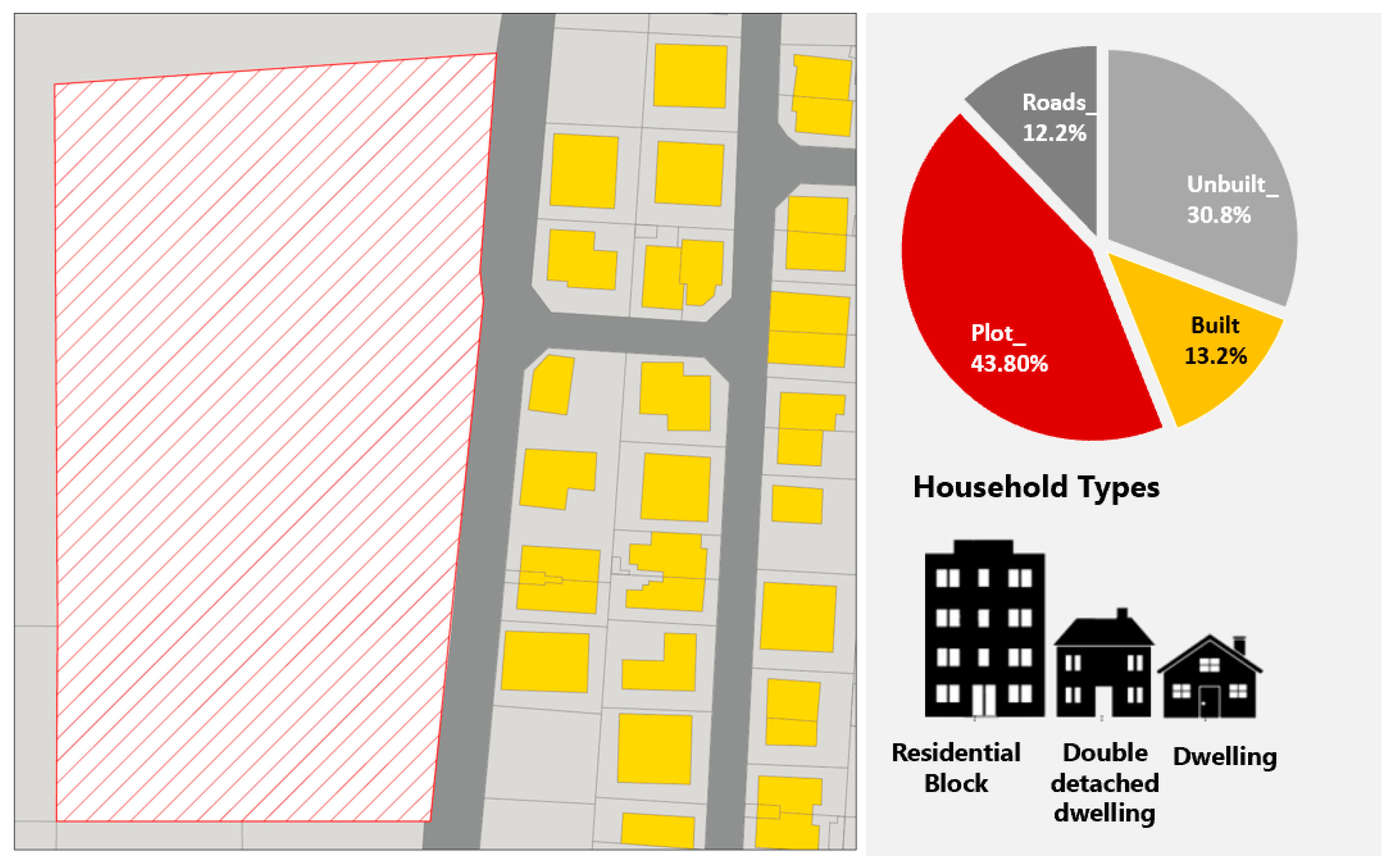
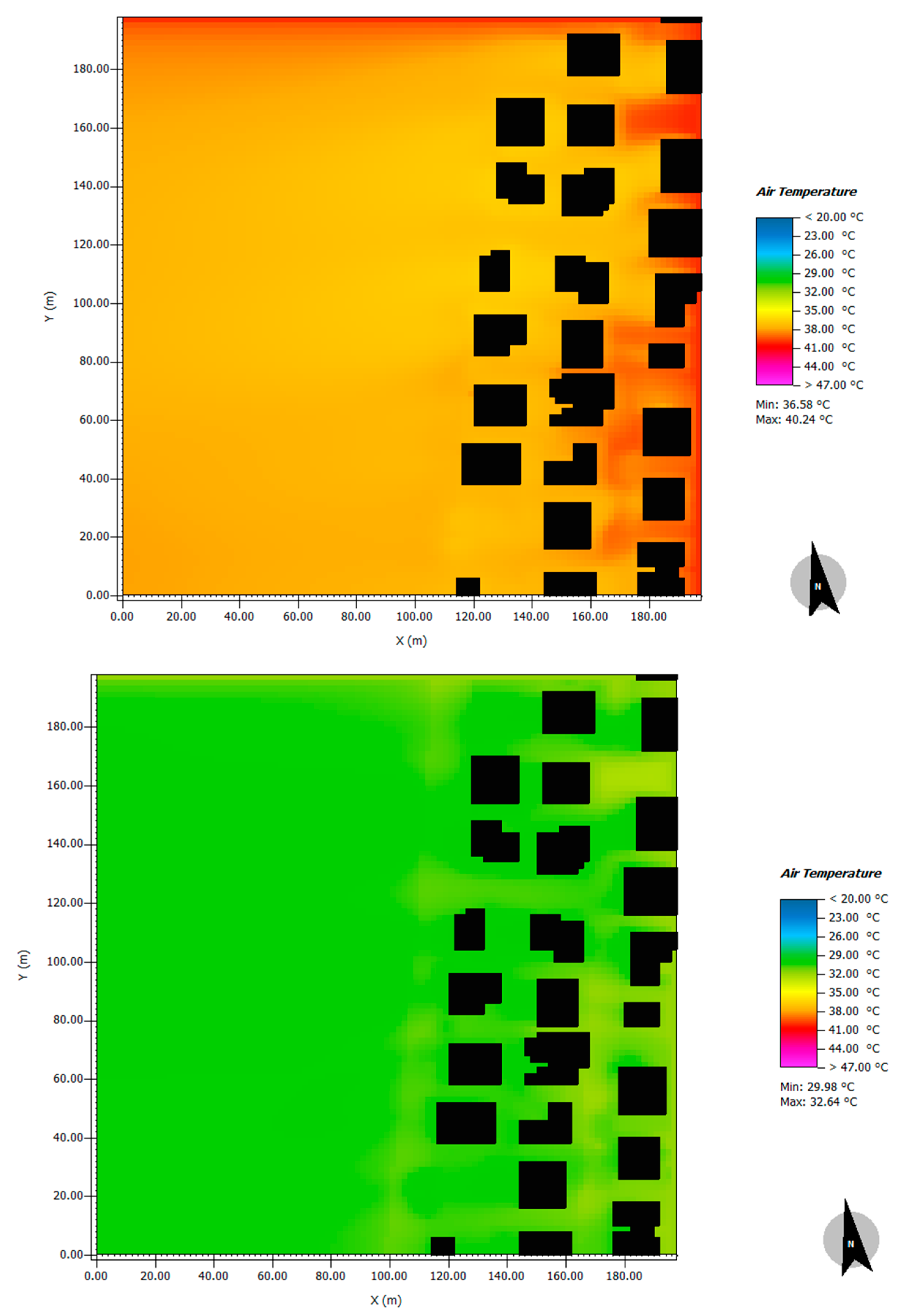
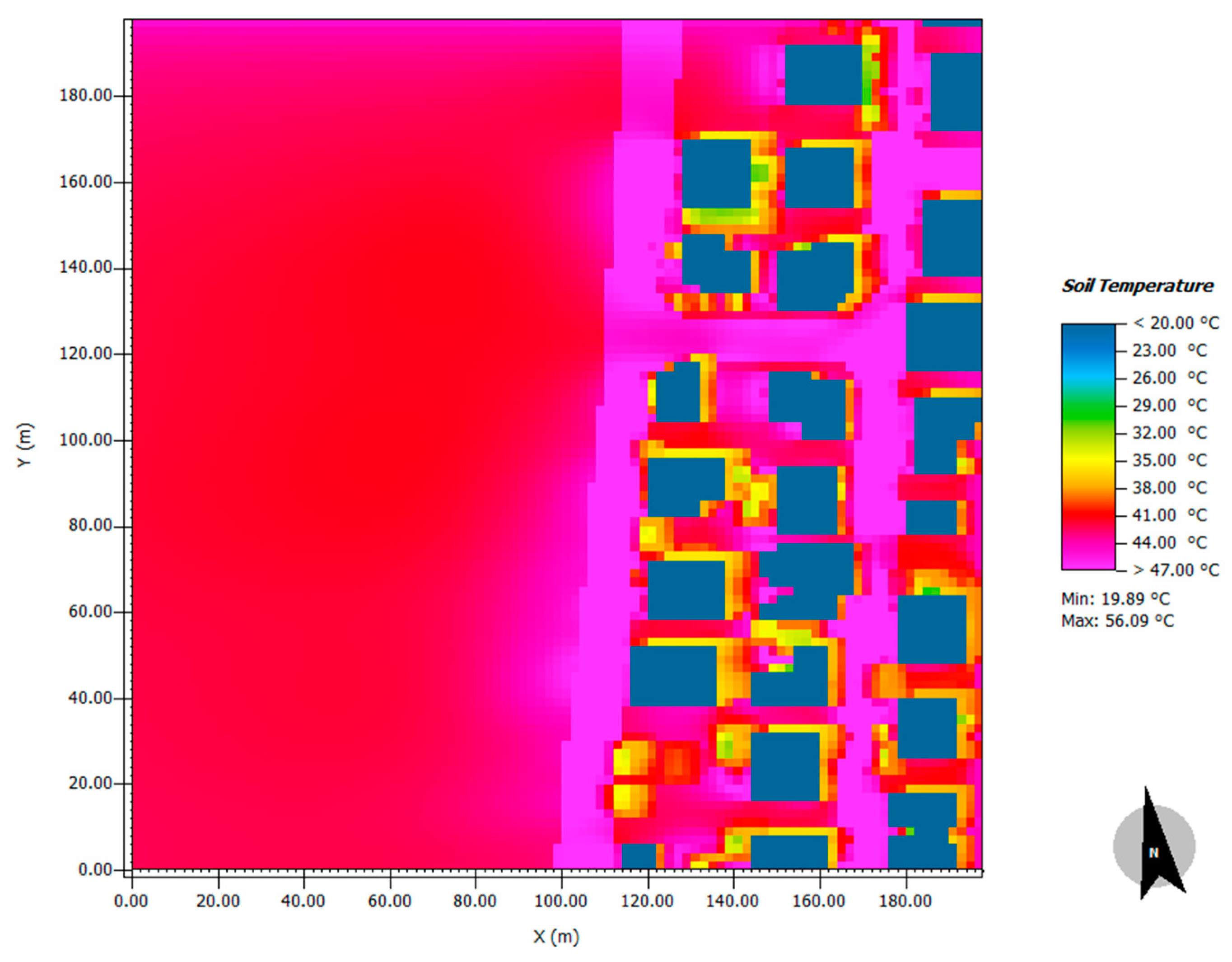
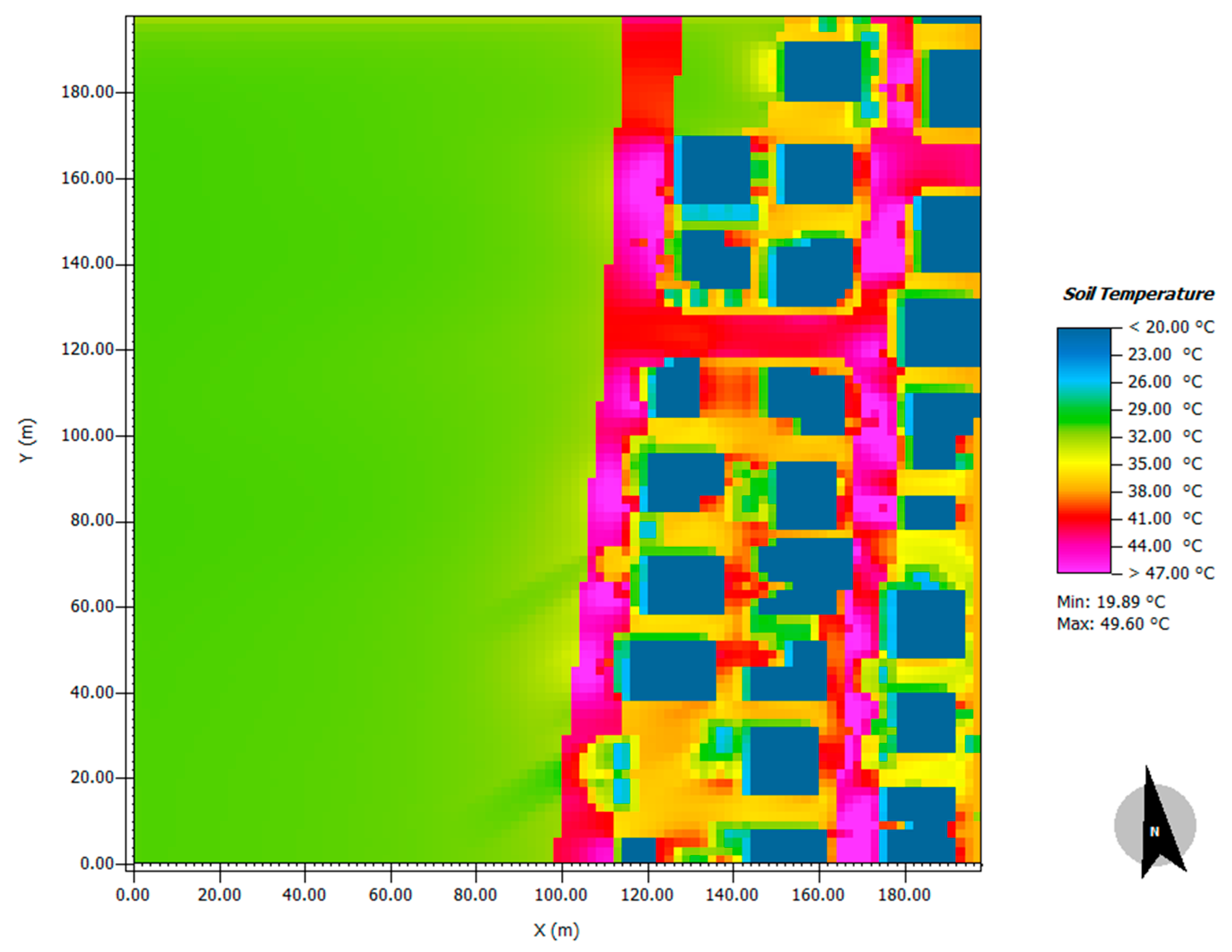
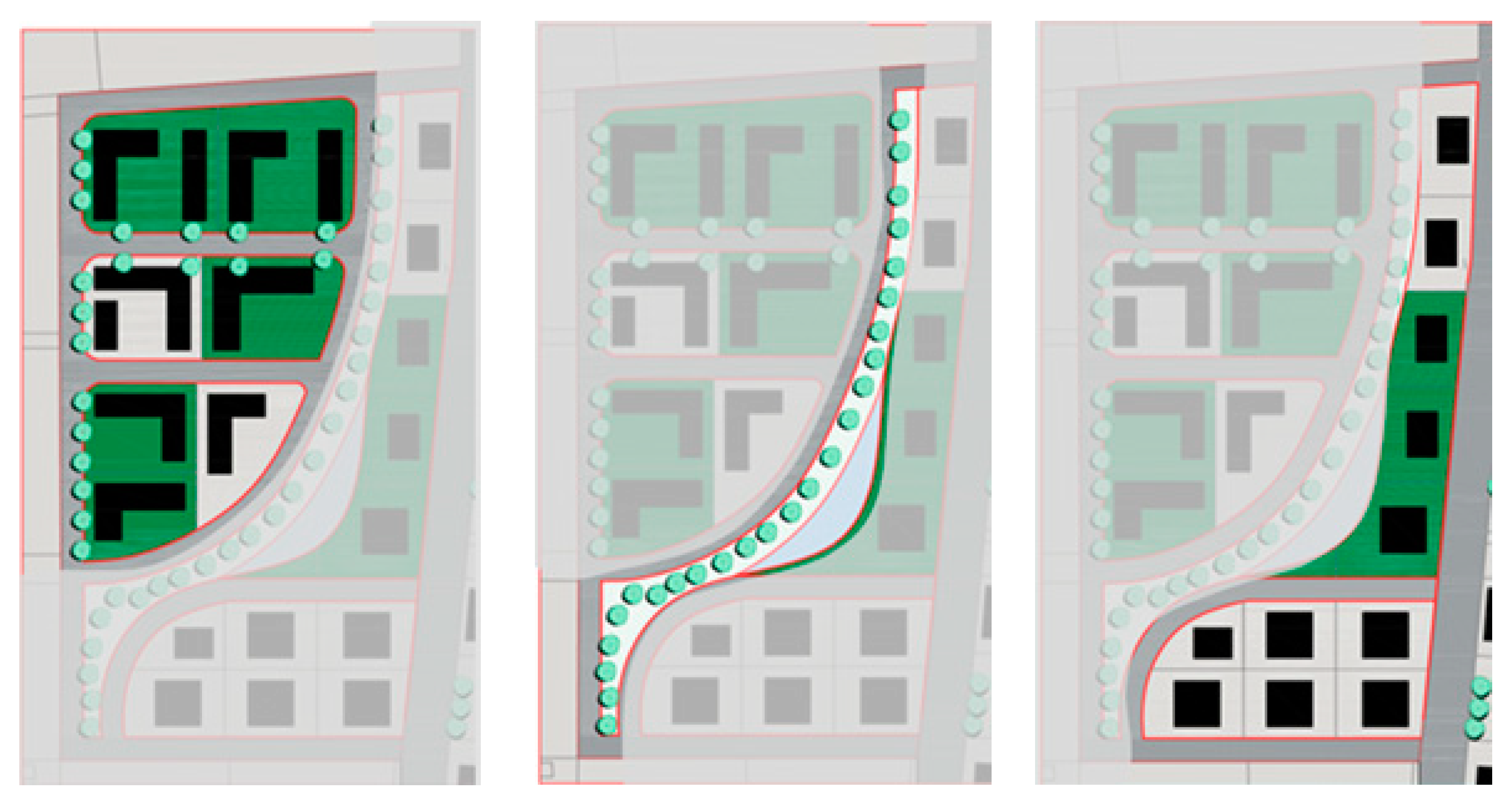
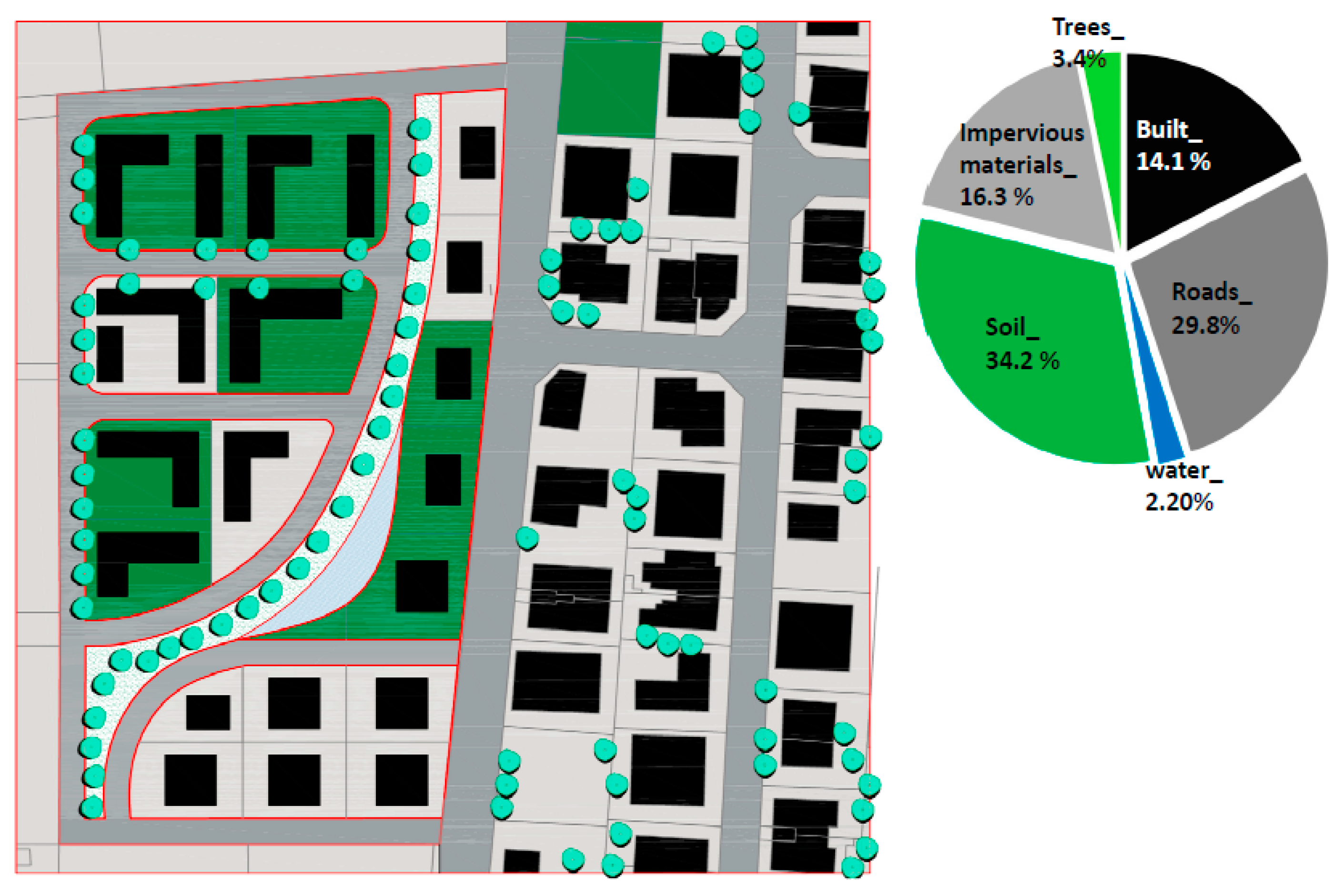
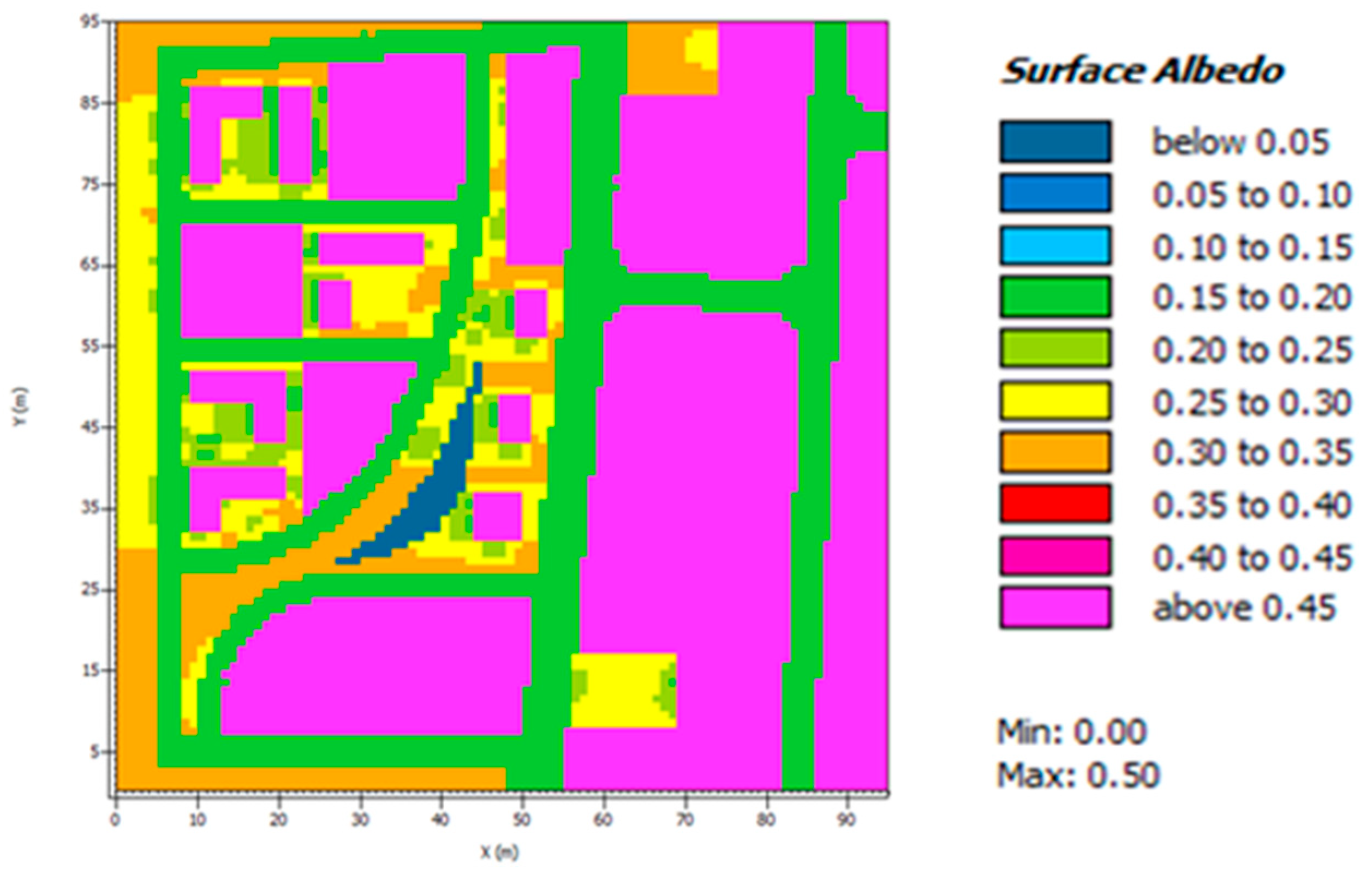
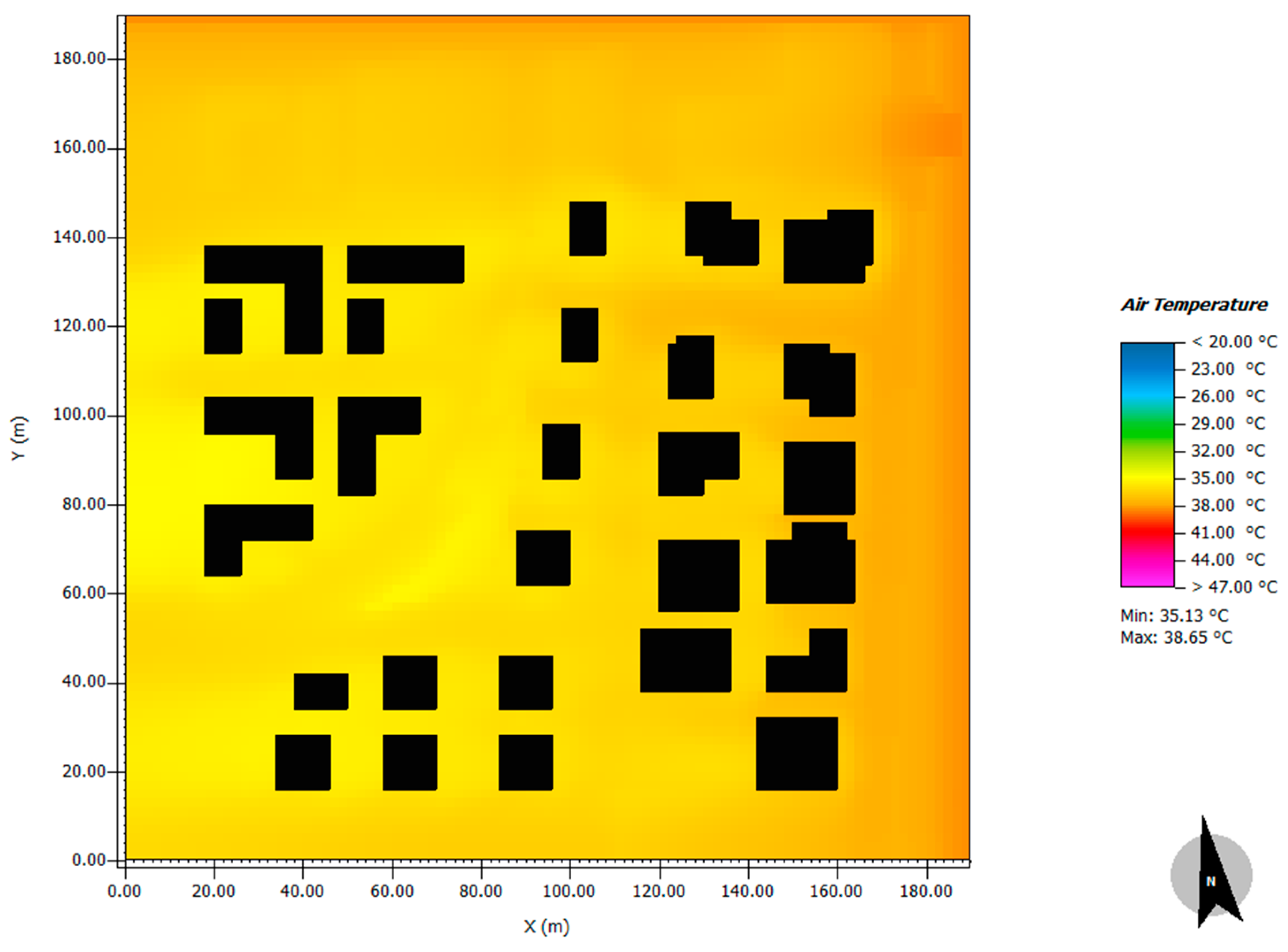
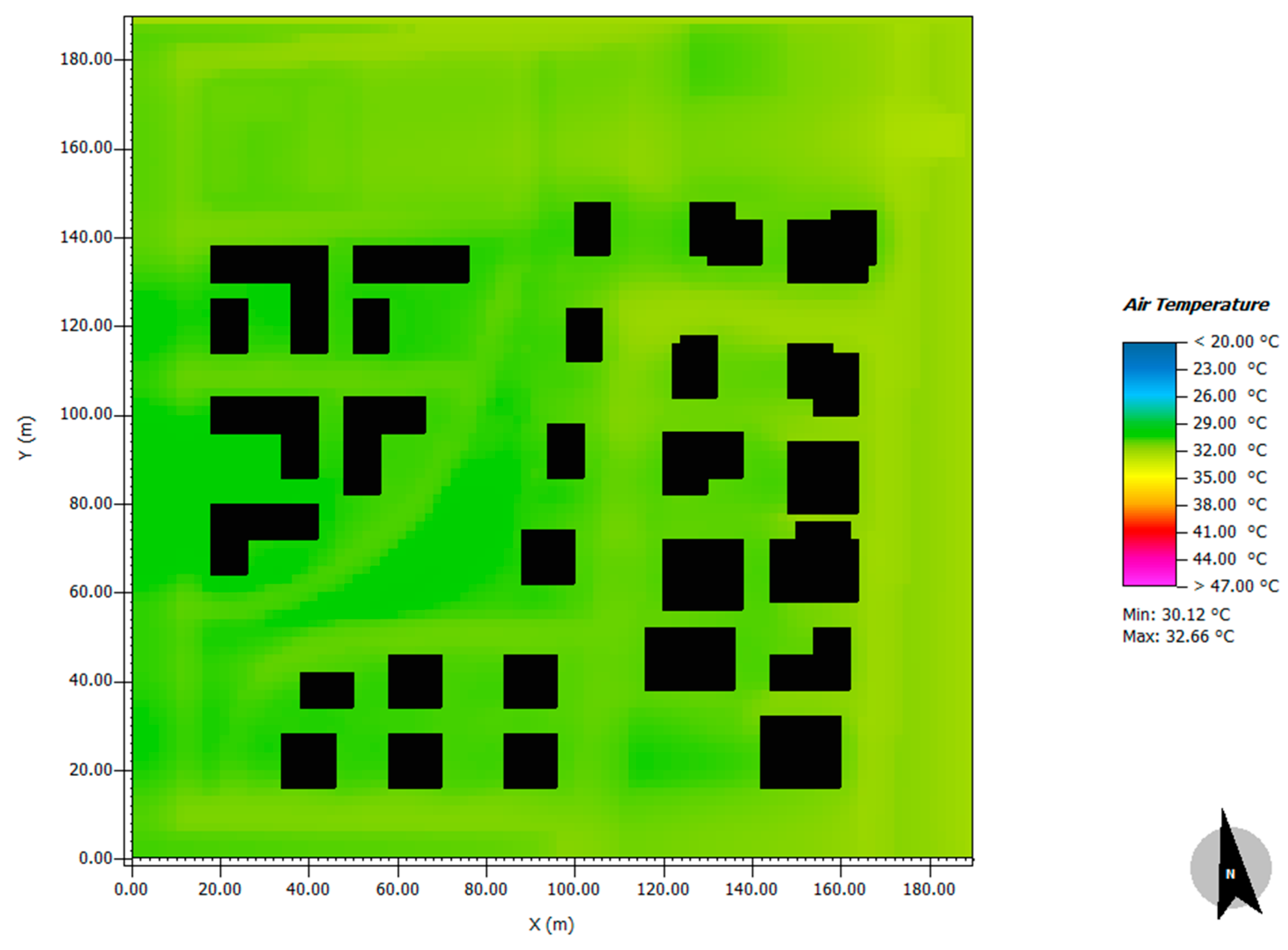
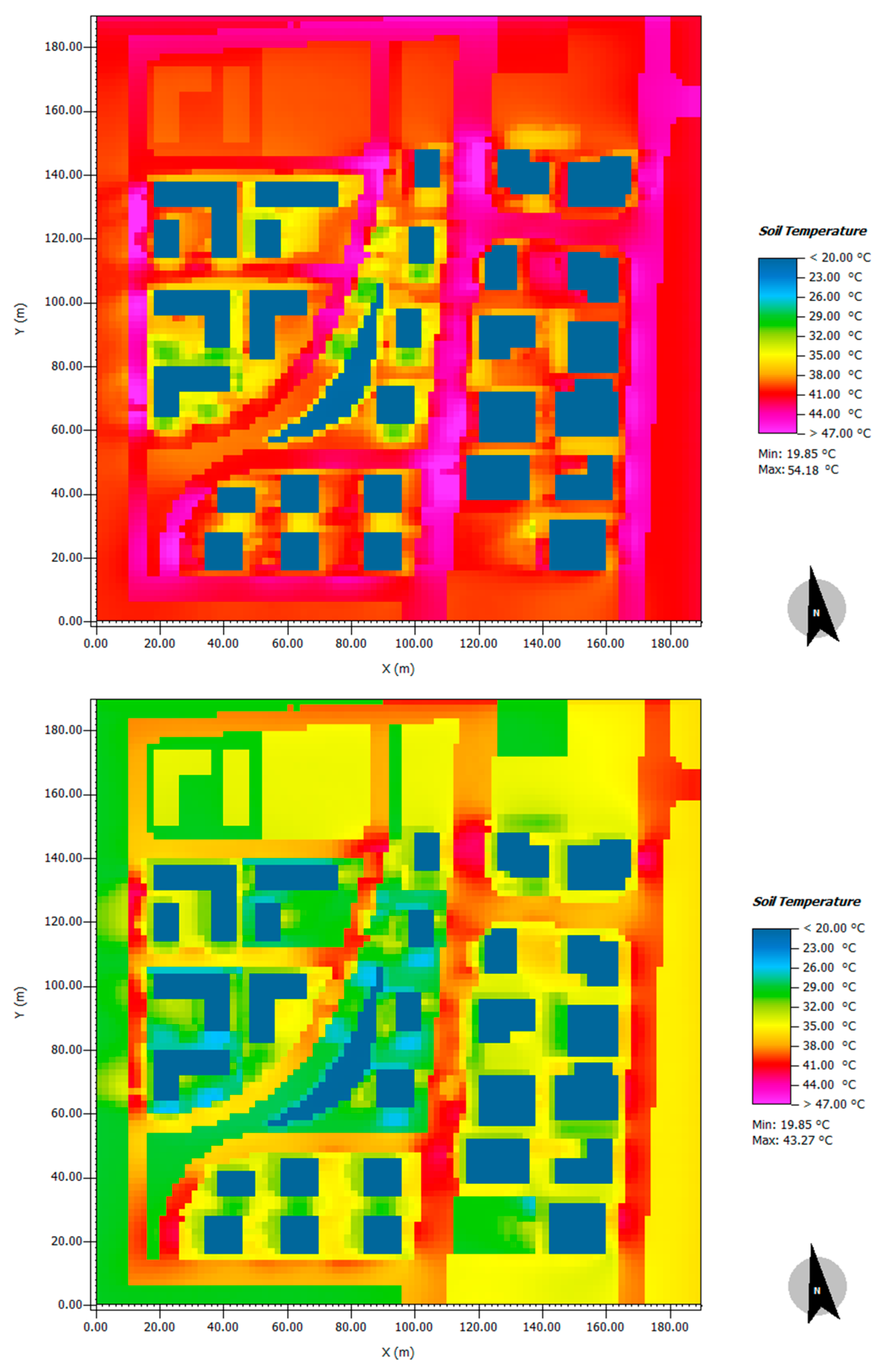
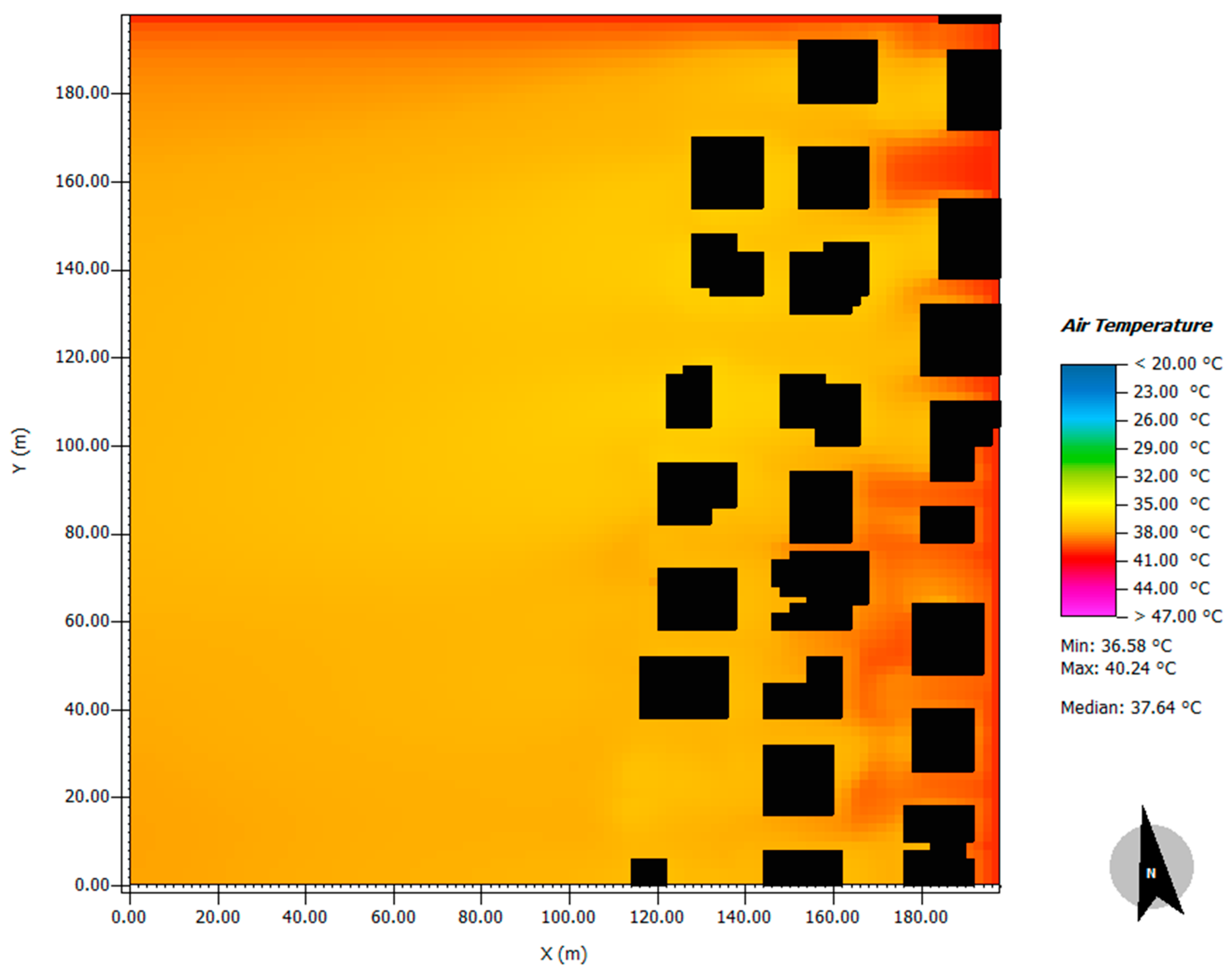
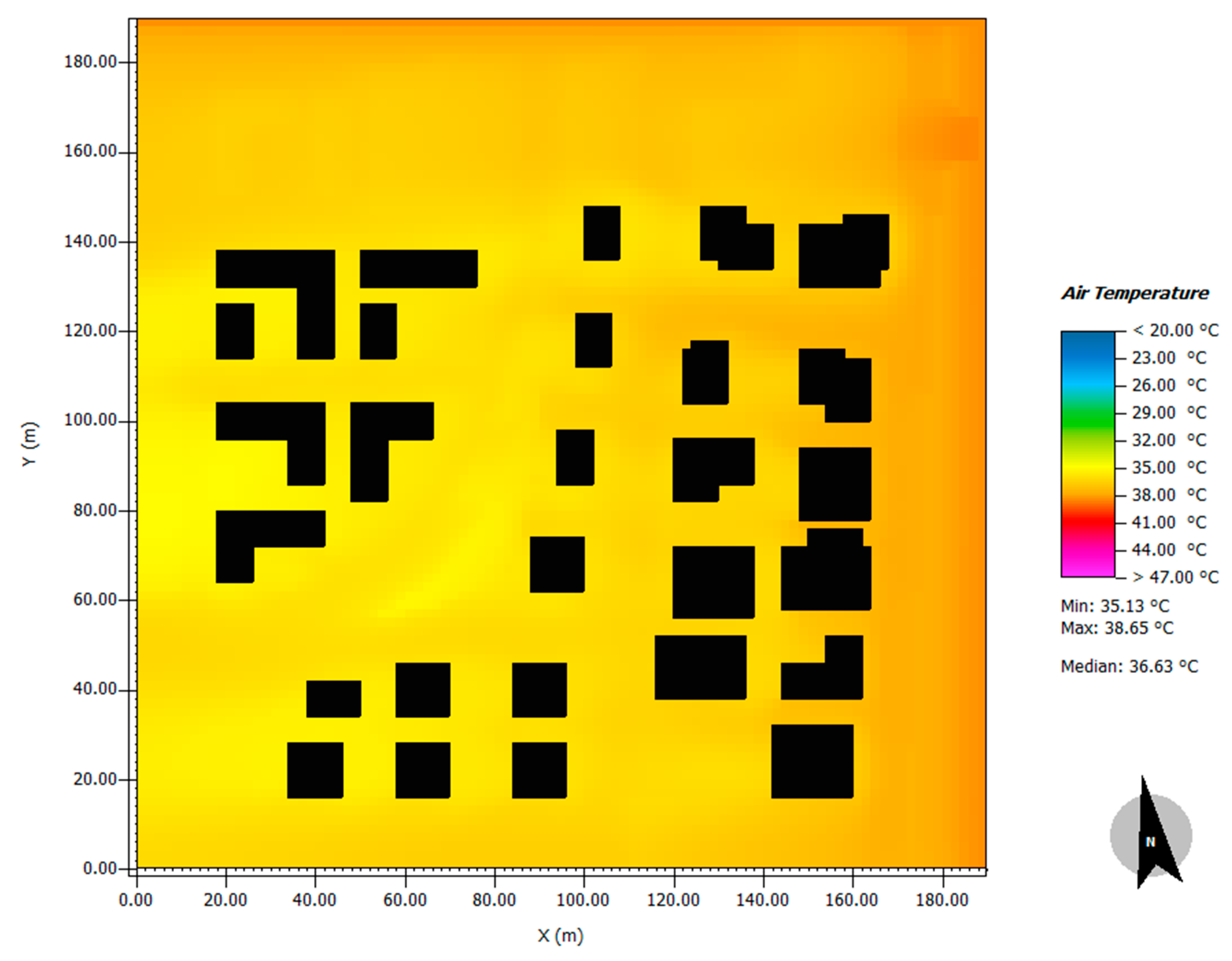
| Parameter | Buildings | Asphalt | Soil | Pavements | Trees |
|---|---|---|---|---|---|
| Absorption | 0.7 | 0.8 | 0.6 | 0.6 | 0.8 |
| Reflection | 0.3 | 0.2 | 0.4 | 0.4 | 0.2 |
| Transmittance | - | - | - | - | 0.3 |
| Emissivity | 0.9 | 0.9 | 0.9 | 0.9 | - |
| Plant Height [m] | - | - | - | - | 5 |
| Specific Heat [J/kg °C] | 1100 | - | - | - | - |
| Thermal Conductivity [W/m °C] | 0.5 | - | - | - | - |
| Density [kg/m3] | 1500 | - | - | - | - |
| Date | T, ENVI-met (°C) | T, Station (°C) | Deviation (%) |
|---|---|---|---|
| 23 June 2022 0:00 | 27.69 | 26.3 | 5% |
| 23 June 2022 1:00 | 26.15 | 25.8 | 1% |
| 23 June 2022 2:00 | 24.62 | 25.7 | 4% |
| 23 June 2022 3:00 | 23.08 | 25.4 | 9% |
| 23 June 2022 4:00 | 21.54 | 24.9 | 13% |
| 23 June 2022 5:00 | 20 | 24.3 | 18% |
| 23 June 2022 6:00 | 21.82 | 23.7 | 8% |
| 23 June 2022 7:00 | 23.64 | 26.3 | 10% |
| 23 June 2022 8:00 | 25.45 | 29.4 | 13% |
| 23 June 2022 9:00 | 27.27 | 31.9 | 15% |
| 23 June 2022 10:00 | 29.09 | 32.6 | 11% |
| 23 June 2022 11:00 | 30.91 | 33.1 | 7% |
| 23 June 2022 12:00 | 32.73 | 35.5 | 8% |
| 23 June 2022 13:00 | 34.55 | 34.5 | 0% |
| 23 June 2022 14:00 | 36.36 | 35 | 4% |
| 23 June 2022 15:00 | 38.18 | 36.7 | 4% |
| 23 June 2022 16:00 | 40 | 35.9 | 11% |
| 23 June 2022 17:00 | 38.46 | 35.9 | 7% |
| 23 June 2022 18:00 | 36.92 | 34.3 | 8% |
| 23 June 2022 19:00 | 35.38 | 32.8 | 8% |
| 23 June 2022 20:00 | 33.85 | 29.8 | 14% |
| 23 June 2022 21:00 | 32.31 | 28.3 | 14% |
| 23 June 2022 22:00 | 30.77 | 27.6 | 11% |
| 23 June 2022 23:00 | 29.23 | 27 | 8% |
| Scenario | Minimum Temperature (°C) | Maximum Temperature (°C) | Median Temperature (°C) |
|---|---|---|---|
| Baseline Scenario | 36.58 | 40.24 | 37.64 |
| Proposed urban development in the unbuild area | 35.13 | 38.65 | 36.63 |
| Air temperature difference | 1.45 | 1.59 | 1.01 |
Disclaimer/Publisher’s Note: The statements, opinions and data contained in all publications are solely those of the individual author(s) and contributor(s) and not of MDPI and/or the editor(s). MDPI and/or the editor(s) disclaim responsibility for any injury to people or property resulting from any ideas, methods, instructions or products referred to in the content. |
© 2023 by the authors. Licensee MDPI, Basel, Switzerland. This article is an open access article distributed under the terms and conditions of the Creative Commons Attribution (CC BY) license (https://creativecommons.org/licenses/by/4.0/).
Share and Cite
Spyrou, G.; Ioannou, B.; Souliotis, M.; Savvides, A.L.; Fokaides, P.A. The Adaptability of Cities to Climate Change: Evidence from Cities’ Redesign towards Mitigating the UHI Effect. Sustainability 2023, 15, 6133. https://doi.org/10.3390/su15076133
Spyrou G, Ioannou B, Souliotis M, Savvides AL, Fokaides PA. The Adaptability of Cities to Climate Change: Evidence from Cities’ Redesign towards Mitigating the UHI Effect. Sustainability. 2023; 15(7):6133. https://doi.org/10.3390/su15076133
Chicago/Turabian StyleSpyrou, Georgia, Byron Ioannou, Manolis Souliotis, Andreas L. Savvides, and Paris A. Fokaides. 2023. "The Adaptability of Cities to Climate Change: Evidence from Cities’ Redesign towards Mitigating the UHI Effect" Sustainability 15, no. 7: 6133. https://doi.org/10.3390/su15076133
APA StyleSpyrou, G., Ioannou, B., Souliotis, M., Savvides, A. L., & Fokaides, P. A. (2023). The Adaptability of Cities to Climate Change: Evidence from Cities’ Redesign towards Mitigating the UHI Effect. Sustainability, 15(7), 6133. https://doi.org/10.3390/su15076133








